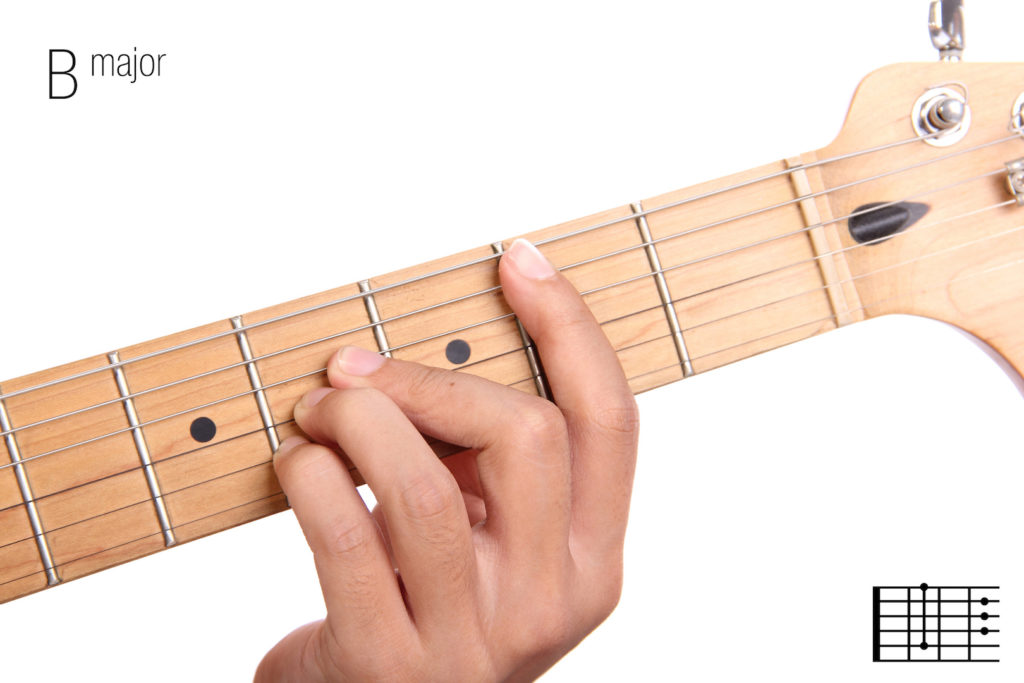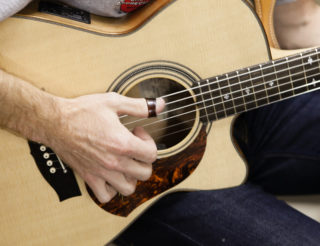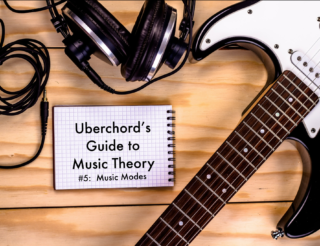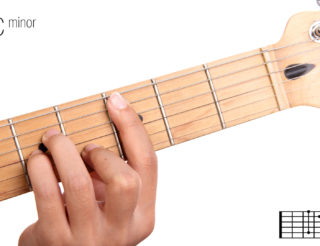B Chord on Guitar: History, Chord Shapes, Major Scale & Songs in the Key of B
Author: Wanda Waterman

We bring you another article in our “Chord of the Week” series, where we share a new guitar chord every week, exploring its history, its relevance, how it’s played on the guitar, its major scale, some common chord progressions, and a few popular songs in its key.
B chord, the root of the key of B Major:
The key of B has long been associated with negative emotions such as rage, intense jealousy, and hopelessness, making it a very important part of the guitarist’s repertoire.
The last part of Igor Stravinsky’s The Firebird, an opera based on a mystifying Russian fairy tale, is in B Major, as is the aria “La donna è mobile” (women are fickle) from Verdi’s opera Rigoletto.

This key doesn’t feature heavily among jazz tracks, except for John Coltrane’s “Giant Steps” and Steely Dan’s “Aja.” In pop music it fares a little better; the Backstreet Boys, Lady Gaga, and Michael Jackson all have a number of B Major songs in their repertoires.
The key of B, with five accidentals— sharps— is a bit tricky for sight readers but on the piano the black keys are easy to reach, and the chords are comparatively easy to play on the guitar. It’s thought of as a “remote” key because of its number of accidentals and its distance from the key of C Major (which has no accidentals) in the cycle of fifths. Learn everything you need to know about about major scales and how they work.
Table of Contents
The B Chord Position on the Guitar: A Bit of a Cram
!function(e,r,d){var t,c=e.getElementsByTagName(r)[0];e.getElementById(d)||(t=e.createElement(r),t.id=d,t.src=”https://uberchord-backend.firebaseapp.com/uberchord-embed-sdk.js”,c.parentNode.insertBefore(t,c))}(document,”script”,”uberchord-jssdk”);
Similar to the A chord, the B chord requires you to cram three fingers together, a singular task if you have big fingers.
But if this is bothersome at first, don’t fret— any chord can be played if you practise it long enough! Even better, the Uberchord app (click for free download) can shorten the duration of practice needed by letting you know exactly what you can do to improve your playing.
Further down the road, when you find yourself having to play progressions of chords that are hard to move back and forth between, you can program in the progressions themselves and get helpful feedback. See our blog post for five great tips on how to learn new chords easily.
Theory and Practice: The Pattern of the B Major Scale Explained
If you’ve already got some music theory under your belt (if you don’t, here’s a great place to start) you’ll know that the tones in a major key go like this:
whole tone, whole tone, half tone, whole tone, whole tone, whole tone, half-tone
In other words, at the third and the seventh positions in the scale there’s a half tone, and between all the other notes there are whole tones. All major keys follow this pattern, so if you ever want to figure out the accidentals for yourself, just start with the root note and count off the above pattern.
This means that the scale of the key of B is made up of a muted string plus the notes B, C#, D#, E, F#, G#, and A#.
Voilà— the B scale, with B at its root and another B, an octave higher, at its pinnacle.
On your guitar strings it looks like this:
Playing scales on your guitar is a whole lot easier after you memorise your guitar’s fretboard notes. Here is a secret technique used by many pro guitarists around the world to learn the fretboard.
The B Major chord, which forms the root of the B scale, is made up of the notes B, D#, and F#— the first, third, and fifth notes of the key of B. On the guitar, using the basic B chord position shown in the picture, these notes arrive in this order: Mute, B, F#, B, D#, and F#.
If you’d like to get a more secure feel for the theory behind the practice of music making, our blog has a helpful set of music theory articles. Knowing music theory will help you to be a better musician and give you the peace of mind that comes with knowing what it all means.
Common Chord Progressions in the Key of B Major
If you were to use every chord in the key of B Major, the following would be the chords you’d use. You aren’t strictly limited to using only the chords in the same key, but it helps to know them, so here they are:
B major – C# minor – D# minor – E Major – F# Major – G# Minor – A# Diminished
Why are the C#, D#, and G# chords minor? Because in the major scale the chords at the second, third, and sixth positions of the key are minor. They just are.
Why is the A# a diminished chord? Because in the key of B it sits in the seventh place, and in major keys all seventh place chords are diminished. Once again, that’s just the way it is, baby.
For variety and greater expressiveness, in the key of B Major the F# chord can also be played as an F#7. Why? Because it sits at the fifth position of the key of B, giving it the honour of being the chord that announces the ending of the musical phrase. (Run through some of the chord progressions listed below and you’ll hear this.)
!function(e,r,d){var t,c=e.getElementsByTagName(r)[0];e.getElementById(d)||(t=e.createElement(r),t.id=d,t.src=”https://uberchord-backend.firebaseapp.com/uberchord-embed-sdk.js”,c.parentNode.insertBefore(t,c))}(document,”script”,”uberchord-jssdk”);
“Red, Red Wine,” by UB40
Adding the seventh note of the key of F# (C#) to the F# chord, creating a F#7, makes the F# chord sound a little more top heavy, as if it’s about to fall over onto the root chord (B) that usually comes next in the chord progression, or, in cases where no chord comes next, giving the musical phrase an unresolved sound.
Check out our previous post on understanding and playing 7th chords and, don’t miss the series on learning and understanding music theory.
In addition to your Uberchord lessons, take a little time to play around with the progressions below to become more familiar with how these chords, depending on their order and context, create a sense of beginning, rising, falling, and ending.
So let’s have another look at the chords in the key of B: B major, C# minor, D# minor, E Major, F# Major, G# Minor, and A# Diminished.
Obviously you can’t just start playing all these chords and expect to sound like a pro. The following are a few common chord progressions in this key. Most of the songs you hear are composed of combinations of these chord progressions. As you play them and get used to their sound, you’ll probably recognise them as familiar.
- B — E — F# — B.
- B — F# — G# — E.
- B — G# — E — F#.
- B — F# — G# — D# — E — B — E — F#.
- (Blues) B — B — B — B — E — E — B — B — F# — F# — B — B.
- C# — E — F#.
- B — E — F# — E.
- F# — E — B.
- G# — E — B — F#.
- G# — F# — G# — F#.
Few Great Songs in the Key of B Major
In your musical studies you may have remarked that each key— and even each chord— that you play has its own particular personality. The key of B, for example, while extremely versatile, is weighted in the direction of downer emotions like despair, fury, and terror.
It can glorify fear, as in Michael Jackson’s “Thriller.”
It can sing of masked pain like Lady Gaga’s “Poker Face.”
It can be a an ode to mean streets and rootless living, like Guns N’ Roses’s “Nightrain.”
or it can be ode to unrequited love like Coldplay’s “Yellow”
Get to know the key of B Major; you never know when you may need it!
And if you haven’t downloaded the Uberchord app (click for free download) yet, here are five great reasons why you should! If you’re first learning to play any of the songs just mentioned, there’s lots of free articles that can help you get started. You can learn about topics such as the gm guitar key, chords to don’t dream it’s over, and zoom pedal board order (if you’re looking for help using your gear).
References:
Rita Steblin (1996) A History of Key Characteristics in the Eighteenth and Early
Nineteenth Centuries, University of Rochester Press, p. 123
The 10 Most Used Chord Progressions in Pop and Rock and Roll










No comments yet - be the first.